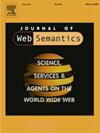Enhancing foundation models for scientific discovery via multimodal knowledge graph representations
IF 3.1
3区 计算机科学
Q3 COMPUTER SCIENCE, ARTIFICIAL INTELLIGENCE
引用次数: 0
Abstract
Foundation Models (FMs) hold transformative potential to accelerate scientific discovery, yet reaching their full capacity in complex, highly multimodal domains such as genomics, drug discovery, and materials science requires a deeper consideration of the contextual nature of the scientific knowledge. We revisit the synergy between FMs and Multimodal Knowledge Graph (MKG) representation and learning, exploring their potential to enhance predictive and generative tasks in biomedical contexts like drug discovery. We seek to exploit MKGs to improve generative AI models’ ability to capture intricate domain-specific relations and facilitate multimodal fusion. This integration promises to accelerate discovery workflows by providing more meaningful multimodal knowledge-enhanced representations and contextual evidence. Despite this potential, challenges and opportunities remain, including fusing multiple sequential, structural and knowledge modalities and models leveraging the strengths of each; developing scalable architectures for multi-task multi-dataset learning; creating end-to-end workflows to enhance the trustworthiness of biomedical FMs using knowledge from heterogeneous datasets and scientific literature; the domain data bottleneck and the lack of a unified representation between natural language and chemical representations; and benchmarking, specifically the transfer learning to tasks with limited data (e.g., unseen molecules and proteins, rear diseases). Finally, fostering openness and collaboration is key to accelerate scientific breakthroughs.
通过多模态知识图表示增强科学发现的基础模型
基础模型(FMs)具有加速科学发现的变革性潜力,但在复杂的、高度多模态的领域,如基因组学、药物发现和材料科学,要充分发挥其潜力,需要对科学知识的上下文本质进行更深入的考虑。我们重新审视了FMs和多模态知识图(MKG)表示和学习之间的协同作用,探索了它们在药物发现等生物医学环境中增强预测和生成任务的潜力。我们寻求利用MKGs来提高生成式人工智能模型捕捉复杂领域特定关系和促进多模态融合的能力。这种集成有望通过提供更有意义的多模式知识增强表示和上下文证据来加速发现工作流程。尽管有这种潜力,挑战和机遇仍然存在,包括融合多种顺序、结构和知识模式和模型,利用每种模式的优势;开发多任务多数据集学习的可扩展架构;创建端到端工作流程,利用异构数据集和科学文献中的知识提高生物医学FMs的可信度;领域数据瓶颈,缺乏自然语言和化学语言之间的统一表示;基准测试,特别是将学习转移到数据有限的任务中(例如,看不见的分子和蛋白质,后方疾病)。最后,促进开放和合作是加速科学突破的关键。
本文章由计算机程序翻译,如有差异,请以英文原文为准。
求助全文
约1分钟内获得全文
求助全文
来源期刊

Journal of Web Semantics
工程技术-计算机:人工智能
CiteScore
6.20
自引率
12.00%
发文量
22
审稿时长
14.6 weeks
期刊介绍:
The Journal of Web Semantics is an interdisciplinary journal based on research and applications of various subject areas that contribute to the development of a knowledge-intensive and intelligent service Web. These areas include: knowledge technologies, ontology, agents, databases and the semantic grid, obviously disciplines like information retrieval, language technology, human-computer interaction and knowledge discovery are of major relevance as well. All aspects of the Semantic Web development are covered. The publication of large-scale experiments and their analysis is also encouraged to clearly illustrate scenarios and methods that introduce semantics into existing Web interfaces, contents and services. The journal emphasizes the publication of papers that combine theories, methods and experiments from different subject areas in order to deliver innovative semantic methods and applications.
 求助内容:
求助内容: 应助结果提醒方式:
应助结果提醒方式:


